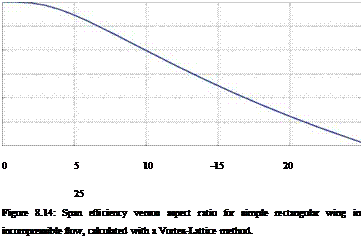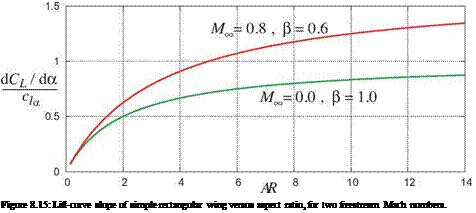Compressible 3D finite wing
Consider a simple, flat rectangular wing with aspect ratio AR and an uncambered airfoil. The objective is to determine its Cl and CD for a given angle of attack a and freestream Mach. Following the PG solution procedure we transform this to x, y,C space where the corresponding transformed wing has
AR = в AR (8.83)
a = в a (8.84)
and its flow-field is governed by the Laplace equation for ф. For a high aspect ratio wing this is approximately solved by classical lifting line theory given in Appendix E. The final results for the lift coefficient (E.37) and induced drag coefficient (E.23) can then be directly applied to the transformed problem,
where cfa ~ 2n is the wing airfoil’s 2D lift-curve slope. An offset to a from the wing airfoil camber has been omitted from (8.85), so that a is in effect measured from the transformed wing airfoil’s zero-lift line. The span efficiency e(2R) depends on the transformed wing’s aspect ratio, as shown in Figure 8.14.
 1
1
0.98 0.96
e
0.94 0.92 0.9 0.88
 |
The 3D lift-curve slope of the wing dCL/да is now seen to depend on в as well as AR, as plotted in Figure 8.18. Two limiting cases or interest are
For a given Cl, the C^ is seen to be mostly unaffected by compressibility, except via the small effect of the span efficiency e which decreases slightly with AR. For a near-elliptical planform we would have e ~ 1,
in which case CD would be essentially independent of ML. This insensitivity of CD to the aircraft flight Mach is consistent with Trefftz-plane theory, in which the lift and the induced drag are implicitly related to each other via the aircraft’s trailing vorticity distribution. The aircraft’s compressible near-field has no bearing on this lift and induced drag relation.











